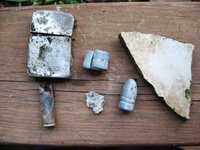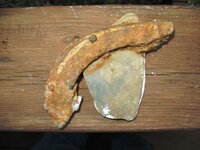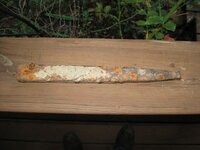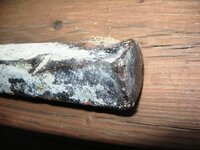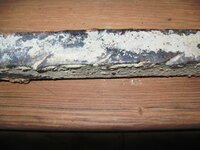Valley Ranger
Silver Member
- Mar 24, 2011
- 2,515
- 1,368
- 🏆 Honorable Mentions:
- 1
- Detector(s) used
- Minelab Equinox 800, Garrett AT Pro (2), Makro Racer 2, Garrett AT Pinpointer (2)
- Primary Interest:
- Relic Hunting
**UPDATE** Here's a photo of the mill dam spike finally preserved. The second image is of the a mill dam in a river in Western Virginia. It was taken in 1899 and the men are using a seine to catch fish. The ladies are on standby to fry the fish or, maybe, to make sure the men don't come up empty handed. 


**End of update.**
Went on a river hunt recently in the Southeastern part of the United States. The area has seen some Civil War action. Didn't do as well this time as I have previously. Below are pics of what I scrounged out of the river- a dropped Confederate Gardner bullet, an old Zippo lighter, melted lead, a piece of pottery, an old shell casing, a lead fishing net weight with part of "Chicago, IL" on the inside, part of a horseshoe still fuzed to some river rock and what appears to be some type of chisel. I'd like some help on that chisel. It's about 10" long and roughly 1" square and you can see it's been blunted on both ends. There are also diagonal slashes on 2 opposite corners. I'm thinking maybe it's a stonemason's chisel, but the slash marks cut into the corners have puzzled.
Both the horseshoe and the chisel were recovered from a ford in the river that dates to the pre-Civil War era. I had wanted to spend a lot more time at the ford as I believe there's are some potential good finds there - but I ran out of time. Thanks for taking a look!



**End of update.**
Went on a river hunt recently in the Southeastern part of the United States. The area has seen some Civil War action. Didn't do as well this time as I have previously. Below are pics of what I scrounged out of the river- a dropped Confederate Gardner bullet, an old Zippo lighter, melted lead, a piece of pottery, an old shell casing, a lead fishing net weight with part of "Chicago, IL" on the inside, part of a horseshoe still fuzed to some river rock and what appears to be some type of chisel. I'd like some help on that chisel. It's about 10" long and roughly 1" square and you can see it's been blunted on both ends. There are also diagonal slashes on 2 opposite corners. I'm thinking maybe it's a stonemason's chisel, but the slash marks cut into the corners have puzzled.
Both the horseshoe and the chisel were recovered from a ford in the river that dates to the pre-Civil War era. I had wanted to spend a lot more time at the ford as I believe there's are some potential good finds there - but I ran out of time. Thanks for taking a look!
Attachments
Last edited:
Upvote
0


